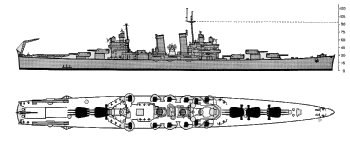![]() The Pacific War Online Encyclopedia
The Pacific War Online Encyclopedia
|
| Previous: Brooke-Popham, Henry Robert Moore | Table of Contents | Next: Brooks, John B. |
 ONI 222 |
|
Tonnage |
9767 tons standard |
|
Dimensions |
608'4" by 61'8" by 21'6" 185.42m by 18.82m by 6.93m |
|
Maximum speed |
33.7 knots |
|
Complement |
868 |
| 2 catapults 4 seaplanes |
|
|
Armament |
5x3 6"/47
guns 8 5"/25 AA guns 8 0.50 machine guns |
| 1798 tons: 5.625" (15.88mm) belt tapering to 3.7" (83mm) backed by 25lb STS steel 5" (127mm) machnery bulkheads tapering to 2" (51mm) 2" (51mm) internal longitudinal magazine protection 3.7" (93mm) magazine bulkheads 2" (51mm) armor deck 6.5"/2"/1.25" (165mm/51mm/38mm) turret front/roof/sides and rear 6" 152mm) barbettes 5" (127mm) conning tower |
|
| Machinery |
4-shaft Parsons geared turbine
(100,000 shp) 8 Babcock & Wilcox boilers |
|
Bunkerage |
1982 tons fuel oil |
|
Range |
10,000 nautical miles at 15 knots |
| Sensors |
Mark 3 radar |
| Modifications |
1942: Added 2 3"/50 AA guns 1942-8: Light antiaircraft armament of 4x4, 4x2 40mm Bofors AA guns. SG, SC, and two Mark 4 radar sets installed. 1943: SC and Mark 3 radars replaced with (typically) SK and Mark 8. 1945: Light antiaircraft armament typically 4x4, 6x2 40mm guns and 10x2 20mm Oerlikon AA guns. |
The Brooklyns
were completed during 1938-1939 and
were the most modern and powerful light cruisers with which the U.S.
Fleet
began the war. The design arose out of the London Conference of
1930, where the U.S. reluctantly agreed to a freeze on further heavy cruiser construction.
This forced the U.S. Navy to turn to light cruiser construction. Though
design studies began as soon as the London Treaty was ratified, a final
design was not accepted until 1934, due to increased awareness of the
need for antiaircraft protection and the appearance of the Japanese Mogamis
with their (initial) armament of 15 6" guns.
The final design matched the enormous number of guns on the Mogamis and used a protection scheme similar to that of the New Orleans-class heavy cruisers, making them the best-protected modern light cruisers in the world (only the Mogamis came close). However, the Brooklyns proved somewhat structurally weak, and their machinery was not well dispersed. They could carry up to six seaplanes in their large hangers, but the usual complement was four.
| Cebu | |
| Pearl Harbor | |
| Pearl Harbor | |
| Nashville
|
arrived 1942-3-15 |
 | 
|

|

|

|

|

|

|

|
References
Gogin (2010; accessed 2013-2-6)
The Pacific War Online Encyclopedia © 2007, 2009, 2012, 2014 by Kent G. Budge. Index